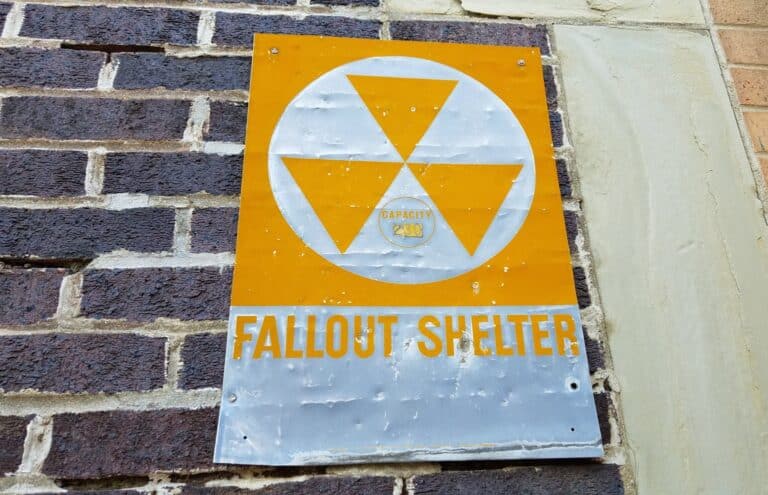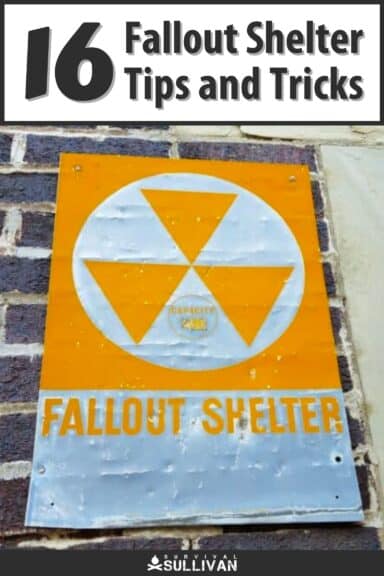It’s hard to imagine anything worse, or scarier, then a nuclear war, and even a single nuclear detonation is nothing short of a catastrophe.

The titanic blast and fireball is bad enough, but if you’re fortunate enough to survive that, or if it just goes off somewhere in your region you aren’t out of the woods just yet.
About half an hour after the blast, deadly, radioactive nuclear fallout is going to be settling back to Earth, and it can easily make you extremely sick or even kill you.
Accordingly, you’ll need to prepare and take hide in an appropriate fallout shelter to stay safe from this insidious threat.
But the problem is a complicated one, especially in the chaos of the aftermath.
To help you stay safe and alive, I’m bringing you these critical fallout shelter tips and tricks to remember in case that fateful day ever comes…
1. Stay Away from the Walls and Ceiling in Small Shelters
If you’re in a smaller shelter, keep as far away from the walls and the ceiling or roof as you can.
That’s because radiation pierces materials and continues traveling, and if you don’t have the benefit of very thick walls or roofing, you can still be catching a dose from the fallout that is accumulating outside.
Remember that a great quantity of heavy or dense material is best, or considerable distance from the fallout itself.
A combination of both will also work, but you might not have that luxury in a small shelter.
2. Get to the Interior of Bigger Buildings that are Intact
If you’re taking shelter in a larger building, whether or not it’s a designated fallout shelter, go to the innermost room on the ground floor or in the basement.
This will ensure that you have the most material and the greatest possible distance between you and the fallout…
But remember to use your head.
A covered atrium or courtyard in the middle of a box-shaped skyscraper won’t offer nearly as much protection for obvious reasons, so you want to choose the innermost room in one of the towers, for instance.
3. Protect Earthen Roofs from Washing Away
If you are taking shelter in a hasty, improvised or earthen shelter you need to take pains to protect the piled earth from washing away.
That’s what’s protecting you from the radiation! One good driving rain might leave you exposed and vulnerable in the coming days and weeks.
To prevent this, before you put on the last little bit of dirt on all sides, spread some contractor plastic or other material over the top and then weigh it down with gravel, rocks or any other convenient objects to keep it from blowing and washing away.
That way, when rain hits the plastic, it will be carried off of the dirt covering, leaving it in place.
4. Ventilation Is a Necessity
Ventilation is mandatory in a fallout shelter, and it’s sadly something that people don’t prepare properly for.
Especially in cramped, small shelters that are completely sealed by Earth or concrete, they can heat up very quickly with successive days of habitation, potentially intolerably so.
If you have a choice, make sure that you equip your shelter with a simple, hand-cranked fan with louvers to keep fallout from getting in.
5. Improvise an Airlock with Wet Sheets
Sometimes you won’t have the luxury of a proper ventilation system, and instead we’ll need to leave the entrance to the fallout shelter open or mostly open.
Drifting fallout can easily get inside in such a case, or driving winds could blow in drifts of the stuff.
You can cut down dramatically on the amount of fallout that gets inside in such a case by hanging up at least two wet sheets from wall to wall and floor to ceiling.
This will act as a filter of sorts that will catch dust and trap it before it can make its way inside, although of course, you’ll have to deal with the potentially dangerously radioactive sheet in the future.
Using two sheets in this way means that there will never be an unprotected opening into the shelter.
6. Improvise a Hasty Shelter from Anything Dense and Heavy
If you have absolutely no time to get to a proper shelter, you can improvise one from any convenient heavy materials.
You can take shelter under a staircase or even beneath heavy furniture like desks or tables that you’ve piled up with sandbags, books, bricks, concrete blocks, or anything else that will impede radiation.
Although the thought of staying in such a cramped space for several weeks might be unthinkable, keep in mind that the intensity of the radiation will degrade quickly and steadily in the coming days.
As such, you might need to hold on for just a few days until things are safe enough for you to move somewhere else.
7. Don’t Forget to Remove and Discard Contaminated Clothes and Footwear
If you are unlucky and get caught in the fallout before you can make it into the shelter proper, you cannot forget to get rid of your contaminated clothing and other gear.
Otherwise, you’ll simply drag radioactive particles into the shelter with you which can certainly sicken or kill you and other occupants.
Keep your wits about you, and strip down entirely just inside the entrance or immediately outside if you have the benefit of cover.
Consider the clothing and other gear lost until it can be properly decontaminated. You might not have your dignity, but you’ll keep your life.
8. You Can Use a Car or Truck to Make a Hasty Trench Shelter
If you’re caught in the middle of nowhere with no hope of reaching an adequate shelter after a nuclear bomb goes off, don’t panic.
Find a ditch that you can park your vehicle over, straddling it on either side.
Then, grab a shovel or anything else that you can, and start piling dirt up around on all sides as quick as you can.
Then you can crawl under and lie on your belly in the trench or ditch beneath the vehicle.
The bodywork of the vehicle combined with the standoff that it provides you will give you a much greater degree of protection compared to facing the fallout sitting inside the cabin.
9. Don’t Trust Any Food or Supplies that Were Exposed to Fallout
If you’re forced to spend a long time inside a fallout shelter and supplies run low, you might be tempted to start scavenging food and other goods from the nearby area.
If that’s the case, you absolutely, positively must not eat anything that was exposed to the fallout!
Not only is fallout radioactive, but it will make anything that it comes into contact with or anything that is nearby radioactive itself.
That can of tuna you pop open and eat will be radioactive sitting inside your stomach, and that could be a fatal mistake.
To be totally clear: Even food that is inside totally sealed containers will still be dangerously radioactive if it has been in contact with or near nuclear fallout!
Radiation will effortlessly pierce all common food packaging to irradiate the contents. Don’t chance it!
10. Use Plastic Sheeting and Tape to Seal Gaps and Cracks
If you have the materials, time, and opportunity you should use plastic sheeting and duct tape to seal up any drafts and cracks inside your shelter to prevent fallout from getting inside.
This works wonderfully for exterior doors, windows, damaged walls or roofs, chimneys and more.
Obviously you’ll still need to allow for some ventilation in smaller shelters, but you should approach the problem with diligence at the beginning of an event.
Letting in fallout when it is at peak radioactivity might prove fatal.
11. Create a Smaller Shelter in Compromised Structures
If you must take shelter inside a structure that’s been it damaged or compromised, meaning it will allow fallout to get to the interior, it might still be able to save you if you create a smaller shelter inside of it.
Use the tips provided on this list, like with the heavy materials, plastic sheeting, duct tape and so forth, to create a functional room that can keep the fallout at bay and keep you alive.
12. You Can Shelter on a Boat on the Water, Too
You aren’t completely screwed if you happen to be out on a boat when a fallout threat emerges.
As soon as you’re able, get the boat out over water that is at least six or seven feet deep.
Make a way to take cover as low as you can in the boat, and protect yourself from fallout, but be prepared to emerge periodically and quickly rinse or sweep the fallout off of the deck and superstructure.
If you can keep the fallout off of the boat, the rest of it will sink down to the bottom of the water and you’ll be protected by the water between you and it.
13. Be Prepared for a Long Stay
If you’re dealing with a very large or very dirty nuclear detonation, or particularly a ground blast, the fallout threat can be extremely severe compared to an air burst from a smaller device.
Accordingly, you must be ready for a long stay in any shelter.
Considering you won’t be able to count on your shoulder having supplies you need, it’s worth your while to always have a go bag with you containing supplies that can ensure while you wait it out.
14. Take Care of Sanitation Concerns with Whatever You Can
One of the most commonly overlooked survival requirements in a fallout shelter is sanitation.
You might be able to cheat this requirement for a couple of days, but not much longer unless you are in a shelter that’s massively under capacity.
Be prepared to take care of business, literally, using any materials you can that will securely sequester the waste.
It could be old water bottles, paint buckets with lids even improvised containers using plastic sheeting and shredded newspaper.
Let this go out of control, and dysentery will probably kill you before the radiation.
15. Decontaminate People and Pets Smartly
As mentioned above, it’s possible that you and your group might reach a decent shelter after the fallout has started to come down.
This doesn’t mean you are dead or dying, but it does mean you must act quickly and intelligently to stay alive.
As before with your clothing, you should stop just outside or immediately inside the shelter, take off all clothing and accessories, and then wash yourself down gently with water starting at the head and moving down.
Do not use any sort of shampoo, conditioner, or lotion because it will bind radioactive particulates to your skin and hair.
Once that is done, get away from the runoff and you’re discarded clothing.
16. Select Good Fallout Shelters Around Your Home and On the Commute
One of the smartest things you can do to be ready for any nuclear event is to pre-select viable fallout shelters around your community and especially along your commute to and from work.
Statistically, you’ll have about a 50/50 chance of being at home or being out and about when it happens, and then about half an hour if you’re lucky before the fallout starts to come down.
Consider that your timetable for getting inside any viable shelter!

The post 16 Critical Fallout Shelter Tips and Tricks to Remember appeared first on Survival Sullivan.
By: Tom Marlowe
Title: 16 Critical Fallout Shelter Tips and Tricks to Remember
Sourced From: www.survivalsullivan.com/fallout-shelter-tips-and-tricks/
Published Date: Mon, 25 Sep 2023 23:00:00 +0000
------------------------
Did you miss our previous article...
https://bushcrafttips.com/bushcraft-news/so-is-vegetable-oil-flammable
 What is BushcraftSurvival SkillsToolsVideosBushcraft CampsBushcraft KitsBushcraft ProjectsPrivacy PolicyTerms And Conditions
What is BushcraftSurvival SkillsToolsVideosBushcraft CampsBushcraft KitsBushcraft ProjectsPrivacy PolicyTerms And Conditions
